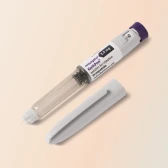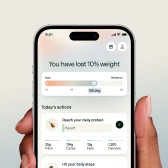A lot of people are interested in medicines like Mounjaro right now. That’s because they’ve been shown to work so well. For some, Mounjaro can lead to a 25% loss in body weight.
Mounjaro works by making you feel full and reducing cravings. It regulates your appetite and blood sugar, while slowing down your digestion.
That said, lifestyle habits play a key role in maximising its effects. For best results, Mounjaro should be used alongside a balanced, nutritious diet and regular exercise—otherwise, it might not work as well.
Okay, but what should that diet actually look like? There’s no specific diet that’s considered best for weight loss, nor one that’s specifically recommended while taking Mounjaro. So, we get that you might feel a little confused about what to put on your plate while using it.
Not to worry—there’s plenty of well-established guidance around eating well for weight loss that we can look to for answers. We’ve summarised it for you below.
Why diet is important when taking Mounjaro?
First things first: Mounjaro may be effective, but it’s not a “quick fix” to losing weight. It’s meant to be taken for at least a year alongside healthy lifestyle changes—including your diet.
That means building long-term, sustainable eating habits. This is what’s going to help you get the most out of the medicine while keeping your body working at its best.
Mounjaro is a weekly injection for weight loss that works by making you feel full. While there’s no specific foods you need to eat or avoid per se, the advice is to eat a nutritious diet with fewer calories than you burn. We definitely don’t recommend extreme diets though, or anything that causes a severe calorie deficit.
A healthy diet provides your body with the energy and nutrients it needs to stay strong and prevent disease, while also supporting weight loss. Foods like whole grains, fruit, and vegetables can fill you up while being lower in calories.
And you’ll want to maintain and build muscle mass on your Mounjaro journey, too. Resistance training can be great for this, but diet is important too—ensure you’re getting enough of the main food groups, in particular protein and carbohydrates.
Plus, a balanced diet can help with certain gut-related side effects you may experience on the medicine. Getting enough fibre can ease constipation, while cutting down on fatty foods can reduce stomach pain, diarrhoea, nausea and heartburn, for instance.
How many calories should I eat per day on Mounjaro?
Mounjaro is recommended alongside a reduced-calorie diet, which usually means that you eat 500-750 calories less than what you would normally use in a day. But you shouldn’t try to consume fewer calories than this.
Introducing a calorie deficit gradually can help you sustain the habit. For instance, you might start with a 150-200 calorie deficit per week, and then gradually build up to 500-750.
What to eat on Mounjaro
Generally speaking, your meals should be balanced and nutritious. We’ve covered what that looks like in more detail below, but broadly, it means that your meals would include the main food groups and be rich in essential vitamins and minerals. This is especially important when eating smaller portions, so you can ensure you’re fuelling your body correctly.
At Voy we advocate for the balanced plate model which involves dividing your plate into portions: typically ½ vegetables or fruit, ¼ lean protein, and ¼ whole grains or complex carbohydrates. It promotes balanced nutrition, portion control and stable blood sugar levels.If you’re taking Mounjaro for type 2 diabetes, speak with your doctor directly about your diet plan.
Okay, now let’s dive deeper into the advice around different types of foods.
Protein
To lose weight, you want to be eating fewer calories while still feeling full—and again, we don’t advise extreme calorie deficit. That’s where protein comes in. Not only does it take longer to digest but it also affects hormones (like ghrelin and GLP-1) that influence our appetite.
Protein is vital to a balanced diet. Your body needs it to build and repair your muscles, tissues (including your bones), and cells. For instance, did you know that your hair and nails are mostly made of protein?
Fish, beans, eggs, tofu, chicken, and lean beef are all examples of protein sources. If you were aiming to eat 1,500 calories a day and get 20% of your energy from protein, that would mean you’d have about 75g of protein per day.
To give you an idea of how that could look:
- 250g salmon has about 50g protein and around 515 calories
- 150g tofu has 12g protein and about 216 calories
- Two eggs have 12g protein and approximately 140 calories
Vegetables
Everyone should eat at least five servings of fruit and veg per day. But as well as being generally good for you (veg is chock-full of essential nutrients your body needs to thrive), this can contribute to weight loss. Vegetables are low in calories but high in fibre and water—which can help make you feel full.
All vegetables are healthy, but some are higher in fibre than others. Fibre can make you feel fuller for longer but it also supports the gut microbiome—a diverse and healthy microbiome is linked to good physical, mental, and gut health.
Vegetables can be categorised as either starchy or non-starchy, depending on how much starch (a type of complex carbohydrate) they contain. Most starchy vegetables, like beans, chickpeas, lentils, and sweet potatoes, are high in fibre. Non-starchy veggies are generally a bit lower in fibre, but there are some exceptions, like broccoli and cooked Brussels sprouts.
Some vegetables that have less fibre are cooked carrots, mushrooms, courgette, asparagus, and pumpkin. Though they’re still rich in antioxidants, vitamins, and minerals, while being low in calories. They can fill you up and are great for you, so there’s no need to avoid them.
Fruit
Like vegetables, fruits are generally low-calorie foods that are nutrient-dense and high in fibre.
But if fruit contains natural sugar, is it really good for weight loss? Yes, definitely. Fruit has been shown to help reduce appetite and overall calorie consumption. It’s got much less sugar than sweetened foods and is a great source of essential vitamins, minerals, and fibre.
For example:
- Strawberries: 32 calories per 100g. They’re also high in vitamin C and fibre
- Watermelon: 30 calories per 100g. A great source of vitamins A and C
- Blackberries: 43 calories per 100g. Rich in antioxidants and packed with fibre
- Peaches: 39 calories per 100g. Naturally sweet and low in sugar, they’re a great source of vitamin A and essential minerals
In short, fruit is really good for you—and, might we add, it’s delicious. A kiwi, apple, or handful of grapes all make for a terrific snack.
When working fruit into your diet:
- Stick to fresh or frozen options. Canned fruits are often in syrup, which is added sugar and increases your calorie intake
- Go for whole fruits rather than juice, as this preserves the fibre content
- Pair fruit with a protein or fibre—like Greek yoghurt or chia seeds—to help you feel fuller
Keep an eye on portion sizes for higher-calorie fruits (think bananas, grapes, or mangoes) if you’re tracking your calories closely. Dried fruit is often high in calories so be mindful of your portion size.
Dairy
Generally, you should try to limit your dairy intake on Mounjaro, as these foods can be high in fat and calories. But in moderation, dairy can be a great source of calcium and sometimes protein—for example, there’s 10g protein in 100g of Greek yoghurt.
Carbohydrates
Carbohydrates are your body’s main source of energy, and they play a key role in any weight loss plan—especially when you're aiming to eat fewer calories than you burn.
But watch out: not all carbs are created equal. Simple carbs—like white bread and pasta, which use refined grains—are broken down inside the body quickly. This gives you a burst of energy but doesn’t do a great job of keeping you full.
On the other hand, complex carbs are broken down more slowly, so energy is released more gradually. Foods like this are rich in fibre and described as low GI—and they can help keep your appetite at bay for longer.
Some carbs you might include in a Mounjaro diet include:
- Sweet or white potatoes (ideally with the skin on)
- Butternut squash
- Corn
- Lentils
- Brown rice
- Wholemeal bread
- Quinoa
- Kidney beans
- Black beans
- Oats
- Bulgur wheat
Healthy fats
Did you know that some types of fat can be good for you?
Yep—healthy fats are an important part of a balanced diet while taking Mounjaro. Not only do they help keep you full, but they also support hormone function and provide essential nutrients like omega-3 fatty acids, which can aid heart health and reduce inflammation.
These fats are a valuable source of energy for your body, and they help it to absorb fat-soluble vitamins (like A,D,E, and K). Plus, they can make meals tastier and more satisfying.
Some sources of healthy fat include:
- Avocado
- Extra virgin olive oil
- Nuts and seeds, like almonds, chia seeds, flaxseeds
- Fatty fish. Think salmon, mackerel, and sardines
- Nut butters, such as almond or peanut butter. Enjoy these in moderation as they can also contain some saturated (i.e. “unhealthy”) fats
Aim to include small portions of healthy fats in your meals, for example as a dressing, cooking ingredient, or a topping. They can add flavour, enhance nutrient absorption, and help to support weight loss in the long term.
Fibre
Fibre is actually a type of complex carb. Like we just explained, that means that the body processes it slower, which can lower your appetite.
And because your body can’t digest fibre, it can also slow down the speed of digestion—which prolongs your feeling of fullness. Fibre also helps to bulk out your stool, which can ease constipation. And it can also keep your gut bacteria healthy.
Research suggests that eating 30g of fibre per day can contribute to weight loss. Wholemeal bread and pasta, brown rice, bulgur wheat, vegetables like broccoli, and pulses like beans and lentils are all high in fibre.
Additionally, incorporating high-fibre foods into your diet, such as oats, can be a great way to support weight loss. For example, porridge is a popular high-fibre option that not only keeps you full but also provides sustained energy.
Heads up: If you’re not used to eating fibre regularly, it might be a good idea to incorporate it gradually. Eating too much at once can bring on gut symptoms like bloating, gas, and constipation.
If that happens to you, you could try cutting down on starchy vegetables, drinking more water, or opting for low-fibre foods like fish or cooked vegetables without the skin on. Always check with your provider if you’re not sure.
What snacks to eat on Mounjaro
That would be snacks that are nutritious, fit into a balanced diet, and are eaten in moderate portions.
A piece of fruit is a great shout. A medium-sized apple is typically just under 100 calories but has 25g carbs and around 4g of fibre, plus nutrients like vitamin C and potassium.
Another option is a slice of wholegrain toast with avocado (we like ours with a squeeze of lemon), or perhaps a few wholegrain crackers with no more than a tablespoon of peanut butter.
Need more inspiration? See our simple snack ideas for Mounjaro to help you stay energised and satisfied.
What to drink on Mounjaro
Does what you drink matter when using Mounjaro? The answer is yes, it does.
Just as Mounjaro may decrease your appetite, many people find it decreases their thirst response too. So it’s important to be mindful and proactive of water intake to prevent dehydration.
Try to avoid drinks that are sugary or high in calories (this is good advice even if you aren’t taking Mounjaro!). Soft drinks are a prime example. A standard can of Coke has 39 grams of sugar but no other nutritional value. You take in these calories but they don’t make you feel full.
What about alcohol? It’s best to avoid alcohol at the start of your Mounjaro journey because it can cause nausea and diarrhoea. You can then gradually introduce it to test out your tolerance as you get used to the weekly injections. But if you do drink, it’s best to do so in moderation.
For one, alcoholic drinks tend to be high in calories. They can also bring on similar side effects to Mounjaro, like nausea and indigestion—which can overlap and make you feel worse. Finally, drinking too much makes some people prone to cravings, usually for high-calorie fast foods.
And don’t forget to stay hydrated! Having around 6-8 glasses of water per day helps keep you healthy but may also contribute to feelings of fullness.
Can I drink coffee on Mounjaro?
There’s no rule against it. But do be careful: Both coffee and Mounjaro can increase your heart rate, so they could have a combined effect. If you’ve ever had any issues with your heart health, check in with your doctor to be safe. Coffee can also be a trigger for side effects like nausea, acid reflux and gut problems. So it’s best to avoid coffee as you start your treatment journey. You can try slowly re-introducing it as you get used to the weekly injections.
Foods to avoid on Mounjaro
There’s no fixed list of foods you can’t have on Mounjaro. But you should try to avoid those that will work against your health goals.
- Highly processed snacks. These are often high in calories, salt, additives, and saturated fats that may not offer any real nutritional benefits. For instance, crisps, instant noodles, or microwave meals.
- Sugary food and drinks. This includes foods with added sugar, like pastries, sweets, soft drinks, and sweetened cereal. Sugars are simple carbohydrates. They’ll give you a rush but are full of empty calories (meaning that they won’t fill you up). They may also spike your blood sugar levels.
- Refined carbs. These provide little nutrition and can lead to blood sugar crashes. For example, white bread, white rice, and pastries.
- Unhealthy fats. While healthy fats are an important part of a balanced diet, unhealthy fats—especially in excess—can interfere with your progress on Mounjaro. These fats often provide little nutritional value, are high in calories, and may increase your risk of heart disease, inflammation, or digestive discomfort.
The two main types of fats to limit or avoid are:
1. Saturated fats: Found in fatty cuts of red meat, full-fat dairy (i.e., butter, cream, cheese), coconut oil, palm oil, and baked goods
2. Trans fats: Found in processed foods, packaged snacks, margarine, fried fast food, and baked goods made with hydrogenated oil
As well as being calorie-dense, unhealthy fats can slow your weight loss progress. Plus, they might bring on (or make worse) symptoms of nausea or digestive upset, and lack the essential nutrients you’ll find in healthy fats.
- Fried and greasy foods. Try to stay away from greasy fried foods, too. Not only are they high in calories but they tend to use oils that contain saturated fats. These can slow digestion and worsen nausea or heartburn. If you are cooking with oil, use just a small amount of those with unsaturated fats—like olive oil. Some examples of fried and greasy foods are fast food, fried chicken, chips, and bacon. As these foods can trigger the side effects of Mounjaro, we recommend excluding them when you start on treatment, and then gradually introducing them once your dose is stable.
- Spicy foods. These may irritate your stomach and trigger digestive discomfort. Think hot sauces, chilli peppers, or heavily seasoned curries.
- Carbonated drinks. It’s possible for fizzy drinks like soda, sparkling water, or energy drinks to increase the pressure in your stomach and cause bloating.
- Alcohol. Alcoholic drinks, like wine, beer, and spirits, can affect your blood sugar, trigger nausea, and reduce your awareness of hunger and fullness cures. Keep these to a minimum when starting, and gradually introduce them back once you’re comfortable on treatment.
Mounjaro diet plan: What does a typical day look like?
While taking Mounjaro, you want your meals to be balanced and nutritious, while keeping an eye on your portion sizes. This will help you make sure you’re getting the right amount of calories and set you up for success.
Generally speaking, you should aim to include one portion of lean protein and another of carbohydrates in every meal—with each filling up ¼ of your plate. We’ve explained this in more detail in the next section.
And above all, try to keep things simple. This will help you stick to your new routine.
The below is just an example—your diet should be tailored to your calorie needs, ideally with the help of a dietician or health provider. At Voy, our team of experts can help you put together a personalised plan as part of our weight loss programme.
Breakfast
- Egg white omelette made with two eggs, about half a teaspoon of olive oil and a tablespoon of cheese, plus one whole-wheat bagel.
- Overnight oats with a serve of fruit and some nut butter.
- Cottage cheese with almonds and cinnamon, plus a piece of fruit on the side.
- Scrambled eggs with kale and tomato, plus a slice of wholemeal toast.
- Protein banana and oat pancakes, plus a handful of berries.
Lunch
- Tuna sandwich made with wholewheat bread, diced celery, and a tiny bit of light mayonnaise. Make a spinach salad on the side.
- Chicken wings with a mixed green and tomato salad plus baked potato fries (use ½ a large potato with ½ tbsp of oil).
- Chicken salad with mixed greens, cucumber, lemon, and dill. Use around 150g chicken breast.
- Roasted chickpea and vegetable salad with wholewheat couscous.
- Wholemeal wraps with salad, hummus or beans, and a lean protein (chicken strips, tofu, turkey slices).
Dinner
- Protein such as lean meat with wholewheat pasta (about ⅓ cup) cooked with a serving of mixed vegetables, plus garlic and onion. Have a serving of steamed vegetables on the side.
- Wraps made with lean protein, such as turkey mince, chicken breast slices, or tofu. Pop some salad in your wraps, too.
- Chili cooked with lean turkey meat, tomato puree, and kidney beans. You can serve it with around 10g of cheddar cheese and 1tbsp of nonfat greek yoghurt.
- Spiced tomato soup with chicken and vegetables, plus a slice of wholewheat bread on the side.
- Stir-fry with chicken or tofu, plus two serves of vegetables. Eat it with wholegrain rice or noodles.
Snacks
- Reach for the fruit bowl: A banana and kiwi have around 150 calories each.
- A slice of wholewheat bread with half a medium avocado, plus a serving of steamed vegetables.
- Crackers and hummus, plus a piece of fruit.
- Celery pieces and nut butter.
- A small tub of plain yoghurt.
For more easy meal ideas and tips on stocking your kitchen with GLP-1-friendly foods, check out our GLP-1 shopping and meal prep guide.
How to eat a balanced meal for weight loss on Mounjaro
We know we’re repeating ourselves here, but this is super important: Diet plays an essential role in maximising your results on Mounjaro. Here, being patient and consistent will set you up for success—especially in the first few weeks of your programme, when changes might not be as noticeable and the effects of the medication may not feel as strong.
There are a few approaches you could take in putting together a balanced meal for weight loss. We like the plate model for its simplicity. Basically, this is a way of dividing up your plate to help you measure out portion sizes for different foods:
- Fill up half your plate with vegetables. Aim for at least two portions: in the UK, one serving of fruit or veg is 80g.
- Carbs (like rice or pasta) should make up one quarter of your plate. Opt for wholegrain options where you can.
- The rest of your plate should be protein, which helps you feel full. Per dietary guidelines, adults should have 0.8g protein for each kilogram of their body weight per day. But eating more protein than this may be beneficial for weight loss.
- You’ll also want to include a small amount of healthy fats, such as olive oil, avocado or nuts.
In clinical research, people using Mounjaro aimed to include in their diet about half of their calories from carbs, 20% from protein, and 30% from fat. They also ate 500 calories less than what they’d typically burn in a day.
If you’d like practical support applying this to your weekly routine, check out our nutrient-dense snacks guide and Mounjaro meal prep tips for simple, coach-approved ways to plan ahead.
Mounjaro diet tips
Okay, now it’s time to put all of the above into practice! Don’t worry, we’re right here with you. Here’s our top tips for creating (and sticking to!) a healthy diet on Mounjaro.
- Eat smaller, more frequent meals. One of the ways that Mounjaro makes you feel full is by slowing down your digestion. So, if you eat larger meals, more food stays in your stomach for longer, which can cause symptoms like discomfort and nausea. Instead, divide your calories over 4-6 smaller meals or snacks. You could try using smaller plates or checking in with yourself as you eat, to see how full you feel.
- Steam or microwave your vegetables. If you’re making plant-based food, steaming or microwaving it can help to retain its nutritional content. This is because you’re not exposing the food to high temperatures or water for a long period of time.
- Use alternative cooking methods. Eating your fruit and veg raw, boiling, pan-frying (putting the food on the pan without added fats), and roasting meat are all better options than frying.
- Prioritise high-protein foods. As we mentioned earlier, protein helps you stay fuller for longer while being lower in calories. It also helps to build and preserve your muscles as you lose weight, which can help your body to burn more calories.
- Choose high-fibre, whole foods. Fibre can also help you feel full, as well as helping move digestion along (which could help with Mounjaro side effects like constipation). Whole foods—those that are close to their natural state, like fruits and vegetables, beans and lentils—are typically higher in fibre while being nutrient-dense. They’re usually lower in calories, too.
- Stay hydrated. Drinking enough water (around 6-8 cups per day) not only keeps your body functioning at its best but may also make you feel full and reduce your appetite. There’s also scientific research suggesting that drinking water may increase the amount of calories your body burns.
- Limit fatty, fried, and spicy foods. Not only can these upset your gut and make your Mounjaro side effects worse, but foods high in saturated fats are often high in calories without having much nutritional benefit. They can definitely work against your health goals.
- Plan your meals. This can help you keep an eye on what you’re eating, so you don’t overeat and ensure you’re putting together a balanced plate. It also helps you stay on track with your new routine.
- Eat slowly and mindfully. If you eat too fast, you might not realise how many calories you’ve taken in—nor when you start to feel full and then you may suddenly start to experience side effects. Instead, eating more mindfully can help you to recognise your body’s fullness cues, so you’ll eat less.
- Track what you eat and how you feel. This can help you spot patterns, like which foods sit well with you or which trigger side effects. You can use a food diary or app to log your meals, symptoms, and energy levels.
Your Mounjaro diet
If that was a lot to take in, we understand. But we want to reassure you that it will get easier: all this new information will start to feel familiar as you settle into your routine.
We’re here to walk you through that process, step by step. Through one-to-one support, our coaches will help you navigate these changes to your diet. They’ll work with you to create a personalised plan of action—and will cheer you on all the way.
It’s all part of our weight loss programme. You’ll also get weekly medication and access to an app to track your progress. Take your next step and get started right now: fill out this short form and we’ll sort the rest.
Want to compare diet plans for different weight loss medications? Check out our expert guides on Wegovy diet plan and Orlistat diet plan to see what works best for you!











